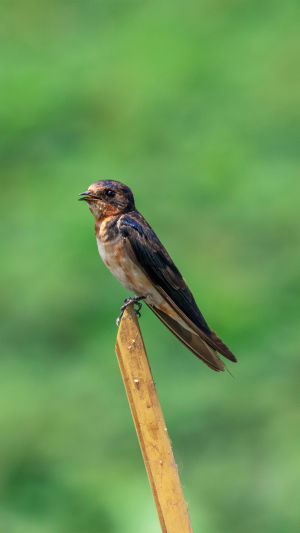Swallows are one of the most familiar birds. They have a close relationship with humans and often even place their nests in human homes, how do they build their nests? Why do swallows have such habits?
Most swallows' nests are made of mud, reinforced with grass stems, and finally covered with soft hay and feathers.
In the past, almost all residential buildings were built with wooden roofs, which made it possible for swallows to build their nests indoors.
The swallows build their nests from the bottom up, placing the mud and grass stems, one by one, layer by layer, and gluing them together with saliva.
The lower part of the nest is small and the upper part is large, and the swallows will leave an opening at the top.
Just like concrete has to have a solidification period, swiftlet nests have to be left to dry for some time after construction, and only after they are dry can they be moved in with soft hay and feathers.
There are several reasons why swallows prefer to build their nests in human dwellings.
1. Human dwellings are suitable for nesting
Compared with the wild environment, human buildings are easier to fix their nests and can shelter from the wind and rain.
2. Humans and swallows get along well
Swallows prey on grasshoppers, moths, crickets, and other pests, and the number of swallows caught per day can reach hundreds, protecting crops from invasion, so swallows have always been a very favourite bird of the ancients, and the two get along very harmoniously.
At the same time, human living places often have more mosquitoes and insects, and swallows also have a richer source of food.
However, swallows do not always live in their hard-earned nests.
In winter, the supply of food for swallows in temperate regions is greatly reduced, so many species migrate.
However, unlike most other migratory finches, swallows migrate during the day and fly at low altitudes.
In addition, they often forage for food during migration and therefore have lower fat reserves than other migratory birds of the same size.
Species that breed in Africa often migrate in response to rainfall patterns, but little is known about the specifics. Other species, such as the grey-rumped swallow, seem to "wander" around and do not have a fixed migration route.
In recent years, the distribution of many swallow species has expanded, as they are increasingly using buildings as nest sites, and these birds are being introduced to areas where they were previously unknown.
For example, Red-fronted Swallows have expanded their range southward to Kenya and Tanzania, and Cave Swallows have moved from Mexico into the southern United States.
Environmental changes also cause shifts in distribution patterns. For example, the British population of house swallows wintered in South Africa, but now their range there has expanded westward due to increased rainfall in the west.





